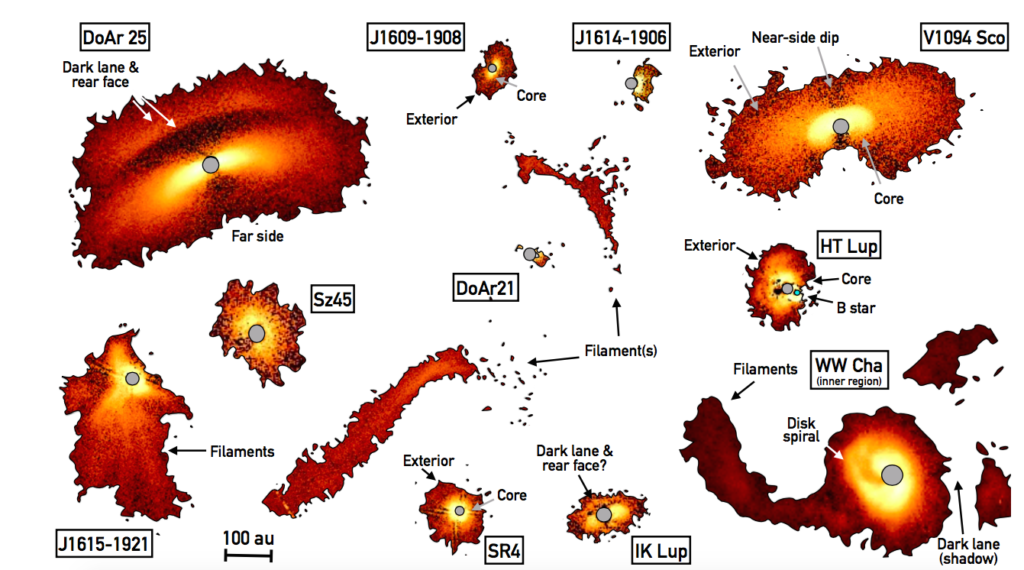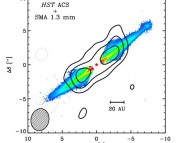Authors: A. Garufi, H. Avenhaus, S. Pérez, S.P. Quanz, R.G. van Holstein, G.H.-M. Bertrang, S. Casassus, L. Cieza, D.A. Principe, G. van der Plas, and A. Zurlo
First Author’s Institution: INAF, Osservatorio Astrofisico di Arcetri, Largo Enrico Fermi 5, I-50125 Firenze, Italy
Status: Accepted for publication in Astronomy & Astrophysics [open access on arXiv]
Scattered Light from Planet-Forming Disks
Ever wondered what our Solar System looked like four billion years ago? While we know that our Solar system was born out of a disk-shaped cloud of dust and gas, called the solar nebula, we want to see planet formation in “real-time”. But to do so, we need instead to look at the dense gas and dust around other young stars. These circumstellar disks provide the raw material for nascent planets and gives us a window into the earliest stages of planet formation. With the advent of new observational facilities such as ALMA, astronomers can now study the birthplaces of planets in exquisite detail. A more complete understanding of the physical and chemical properties of these disks not only lets us learn more about the birth of our Solar System, but helps to better contextualize the vast demographic diversity observed in the exoplanet population. In particular, newly-formed planets leave detectable imprints in their disks – a signature only accessible to high resolution observations. In today’s astrobite, we take a look at new scattered-light images of planet-forming disks, which reveal a variety of disk substructure, provide important constraints on planet formation, and constitute the largest sample of such observations to date.
The DARTTS Survey: Toward an Unbiased View of Disk Surface Features
Today’s authors used the Spectro-Polarimeter High-contrast Exoplanet REsearch (SPHERE) instrument on the Very Large Telescope (VLT) in the Atacama Desert of northern Chile to image 21 new disks in scattered light. These observations are part of a larger program called Disks ARound TTauri Stars (DARTTS). As the name suggests, this campaign seeks to image circumstellar disks around a class of very young, low-mass stars called T Tauri stars that serve as the progenitors of planetary systems. This work is the second data release from this program and adds to an already-imaged sample of 8 disks, but importantly, focuses on disks around even younger stars (with ages around 2 Myr), which is crucial to better understand the earlier phases of disk evolution and to search for the signatures of newly-formed or currently-forming planets.
Using large telescopes operating at near-infrared (NIR) wavelengths, astronomers are able to detect stellar light bouncing off of micron-sized dust grains in circumstellar disks. This is done, in detail, by using a polarimeter to disentangle the stellar light, which is mostly unpolarized, from the strongly polarized light scattered by the disk surface. As this dust is optically thick at NIR wavelengths, such observations can only probe the disk surfaces. All of the DARTTS systems are, in astronomical terms, extremely close to Earth with distances ranging from 230 to 550 light-years away. Despite these nearby distances, scattered light imaging remains difficult, as the faint light reflected from disks is vastly dimmer than the bright light coming from the parent stars. Even so, the DARTTS team detect disk surface structure (often strikingly so) in more than half of their total sample as shown in Figure 1. In particular, a disk silhouette is prominent in the DoAr 25 system, while disks associated with DoAr 21 and WW Cha exhibit filamentary and spiral substructure, respectively. In the latter case, these extended substructures hint at the presence of peculiar processes, such as disk accretion or photo-evaporation, occurring in the nearby medium.

Comparing NIR and Millimeter Views of Disks
As mentioned above, one of the crucial limitations of scattered-light observations is the inability to see deeper than the disk surface layer. However, complementary observations taken with ALMA at millimeter wavelengths offer a solution. Millimeter wavelengths, which trace larger, mm-sized grains, are able to uncover deeper layers within the same disks, probing closer to the disk mid-plane. A direct comparison of scattered-light and ALMA images, as illustrated in the left panel of Figure 2, reveals an absence of rings, gaps, and radial structure in the NIR. In general, this is consistent with the scarcity of shadows and spirals found in the DARTTS sample, which supports the idea that such features are only associated with older or more massive disks, such as those commonly found around Herbig Ae/Be stars. The authors also compare differences in disk sizes between the ALMA and SPHERE images, as shown in the right panel of Figure 2. The disks as seen in the NIR are on average 50% larger than in the millimeter. This apparent trend between NIR-millimeter disk size also suggests that some of the DARTTS scattered-light non-detections (e.g., numbers 7, 11, 13, and 15 in the right panel of Figure 2) may be explained by the presence of intrinsically small disks.

Implications for Disk Evolution and Planet Formation
These new results represent an important demographic analysis of nearby, young planet-forming disks. As such, these observations help alleviate existing biases, in which only massive or old planet-forming disks have previously been imaged in scattered light. Impressively, half of these disks are the least massive disks ever observed and in one case, for J1603-2031, the estimated dust mass is as low as a single Earth mass. With sensitive instruments like SPHERE, scattered-light images such as these will continue to provide us unique and close-up views of planet-forming disks and in doing so, shed new light on the processes responsible for sculpting planets out of dusty circumstellar disks.




